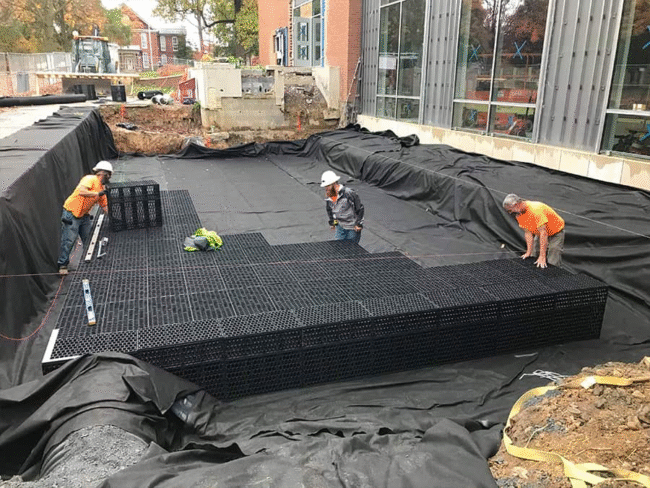
As urban areas continue to expand, the challenge of managing stormwater becomes increasingly critical. Effective stormwater management not only protects property and infrastructure from flooding but also ensures that our waterways are free from pollution. In the pursuit of sustainable development, innovative strategies for handling stormwater are essential. One such solution that has gained attention for its effectiveness and efficiency is the stormwater storage tank system.
Understanding the Impact of Urbanisation on Stormwater Management
Urbanisation alters natural landscapes, replacing permeable surfaces with impermeable infrastructure such as roads, buildings, and pavements. This change significantly affects the way water moves through an environment, causing excess stormwater to accumulate rapidly during heavy rain events. Without proper stormwater management systems in place, this can lead to flooding and the degradation of aquatic ecosystems.
Benefits of Advanced Stormwater Storage Systems
Modern stormwater storage solutions offer multiple benefits over traditional methods. They are designed to mimic natural hydrological cycles, promoting the infiltration and attenuation of stormwater. By managing runoff close to its source, these systems can reduce the burden on municipal storm drains and treatment facilities. This approach also minimises the risk of flood damage and prevents pollutants carried by stormwater from entering natural water bodies.
Stormwater Storage Tanks: A Sustainable Choice
Stormwater storage tanks represent a sustainable choice for urban developments. These tanks are engineered to store excess rainwater temporarily, releasing it at a controlled rate or allowing it to infiltrate back into the soil. Usually installed underground, these storage solutions save valuable land space and can be integrated into various landscapes, including green spaces and parking areas.
Features of Innovative Stormwater Storage Solutions
Innovative stormwater storage solutions boast several features that enhance their sustainability and performance. They are designed to be highly durable, withstanding the pressure of underground installation and the weight of vehicles when integrated into load-bearing areas. These systems are also modular, allowing for flexibility in design and capacity to accommodate different development sizes and rainfall patterns.
Water Quality and Stormwater Storage
Aside from flood mitigation, ensuring water quality is a crucial aspect of stormwater management. Advanced storage solutions often include treatment stages that filter out sediments and pollutants before the water is discharged or infiltrated into the ground. This dual function helps to maintain the integrity of the water cycle and supports the health of aquatic ecosystems.
The Versatility of Stormwater Storage Tanks
One of the strengths of innovative stormwater storage tank systems is their versatility. They can be tailored to meet the specific needs of different projects, from residential developments to industrial complexes. Additionally, these systems can be utilised to harvest rainwater, providing a supplementary water source for non-potable uses such as irrigation and toilet flushing.
Stormwater Storage and Climate Resilience
As we face the reality of climate change, creating resilient urban environments is imperative. Climate resilience involves preparing for and adapting to changing weather patterns, such as increased rainfall intensity. Stormwater storage solutions play a pivotal role in building this resilience, helping communities to manage the impacts of extreme weather events effectively.
Regulatory Requirements and Storage Systems
Governments and local authorities often set regulatory requirements for stormwater management in new developments. Innovative stormwater storage solutions easily meet and often exceed these regulations, providing developers with systems that align with environmental standards and best practices. This level of compliance is essential for gaining project approvals and fostering community support.
Community Engagement and Stormwater Infrastructure
The success of stormwater management strategies also depends on community engagement. By educating the public about the importance of sustainable stormwater infrastructure and its benefits, local authorities can promote the adoption of these systems. Transparent communication about the role of stormwater storage tanks in flood prevention and water quality can encourage community backing for sustainable development initiatives.
Long-Term Cost Savings and Stormwater Systems
The initial investment in a stormwater storage system can be offset by long-term cost savings. These systems reduce the need for extensive drainage networks and treatment facilities, lowering the financial burden on municipalities. Additionally, the mitigation of flood damage and the preservation of water quality can result in economic benefits for both public and private stakeholders.
Innovation as the Key to Sustainable Stormwater Management
Innovative solutions such as stormwater storage tanks are essential to the future of sustainable urban development. These systems not only address immediate environmental concerns but also contribute to the long-term sustainability of cities. They embody a proactive approach to water management, anticipating future challenges, and delivering resilient infrastructure.
Conclusion
In conclusion, the integration of innovative stormwater storage solutions in urban planning is crucial for sustainable development. By installing systems like stormwater storage tanks, we can effectively manage excess runoff, improve water quality, and build climate-resilient communities. It is through the adoption of such forward-thinking technologies that we can safeguard our environment while continuing to accommodate urban growth responsibly.
The Path Forward
As society continues to grapple with the environmental challenges posed by urbanisation, the role of innovative stormwater management solutions will only grow in importance. These systems, including stormwater storage tanks, represent a practical and effective path forward in our quest for sustainable urban development. By prioritising these solutions today, we lay the groundwork for healthier, more resilient cities of tomorrow.
